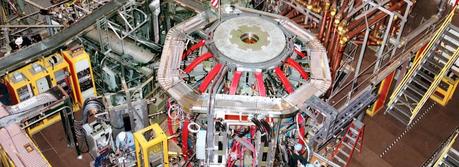
Outside view of the NSTX reactor (Photo credit: Princton's Information Services Office, Princeton Plasma Physics Laboratory)
An important stage of the $94 million upgrade of the National Spherical Torus Experiment (NSTX) has been finished at the U.S. Department of Energy’s Princeton Plasma Physics Laboratory (PPPL). Engineers and scientists have sealed and insulated the first quadrant of magnetic field conductors for the NSTX center stack, which forms the heart of the upgrade.
Completion of the first quadrant entailed some anxious moments. Riding on the results were months of work assembling the nine 20-foot long, 350-pound conductors and preparing them for a volatile process known as vacuum pressure impregnation (VPI) that created the insulation. “If we had a script, I couldn’t think of a better outcome,” Ron Strykowsky, head of the NSTX Upgrade, said of the finished quadrant.
Readying the conductors for the process required the coordinated efforts of engineers and some dozen skilled technicians. The many jobs included soldering cooling tubes into each conductor under the direction of Steve Jurczynski, head of the vacuum braze shop, and sandblasting, priming and wrapping the units with fiberglass tape in operations led by machine technician Mike Anderson.
All these efforts were on the line during the VPI procedure. “When everything’s said and done, you must join the conductors and provide mechanical and electrical strength,” said Jim Chrzanowski, who heads the center-stack construction team. “VPI does both those things and it’s a very delicate process.”
Technicians led by vacuum technician Buddy Kearns began the process by injecting liquid epoxy into a carbon steel, vacuum-sealed mold that engineer Bruce Paul designed. The first quadrant lay inside. Workers gradually raised the temperature to combine the epoxy with the fiberglass tape to create a composite insulating material.
The critical moment came when the process neared 100 degrees centigrade—the temperature at which water boils and the epoxy generates heat and turns solid in what is called an exothermic reaction. The danger was that a sudden runaway reaction could cause the epoxy to burn itself up and destroy the project. Adding uncertainty was the fact that PPPL had never before used this particular epoxy. “We held our breath and were on pins and needles,” recalled engineer Steve Raftopolous.
These anxious minutes passed without incident. The now-solid epoxy cured at 100 degrees for 10-to-12 hours, and at 170 degrees for a similar period. Workers then opened the mold and examined the quadrant. “As soon as we lifted the lids off the mold everyone felt better,” said Anderson
What the team found was gratifying. The process produced uniform insulation throughout the quadrant with just a few cosmetic blemishes. And the insulation easily passed electrical tests. While the composite material needed to show a resistance of at least 1 billion ohms to keep the current in each conductor separate, the insulation measured 20 billion ohms and did so between all nine conductors. “That’s as good as it gets,” Strykowsky noted.
The near-perfect results bode well for the three remaining center-stack quadrants. “The fact that the first one came out so well is an incentive to do the other three the same way,” said Kearns. “It gives us a more comfortable feeling that we can get this done successfully.”
PPPL is managed by Princeton University for the U.S. Department of Energy’s Office of Science, which is the largest supporter of basic research in the physical sciences in the United States.
PPPL, located on Princeton University’s Forrestal Campus in Plainsboro, N.J., is devoted to creating new knowledge about the physics of plasmas—ultra-hot, charged gases—and to developing practical solutions for the creation of fusion energy. Through fusion, which is constantly occurring in the sun and other stars, energy is created when the nuclei of two lightweight atoms, such as those of hydrogen, combine in plasma at very high temperatures. When this happens, a burst of energy is released, which can be used to generate electricity.

